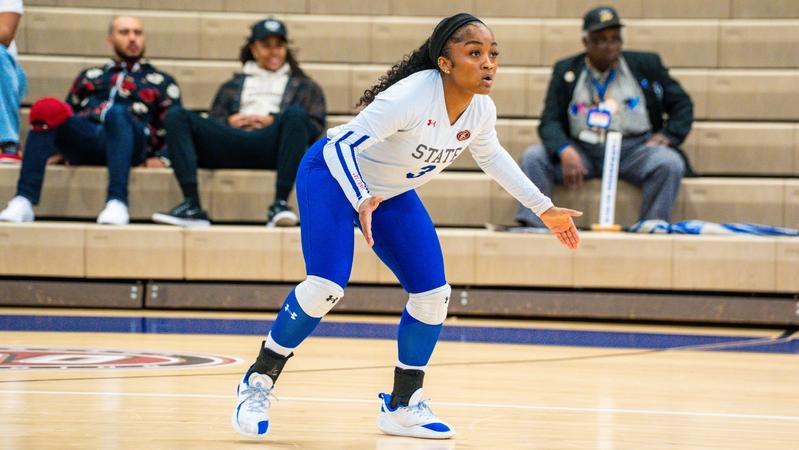College Sports
2025 NHL draft live updates: 7-round, 32-team pick tracker
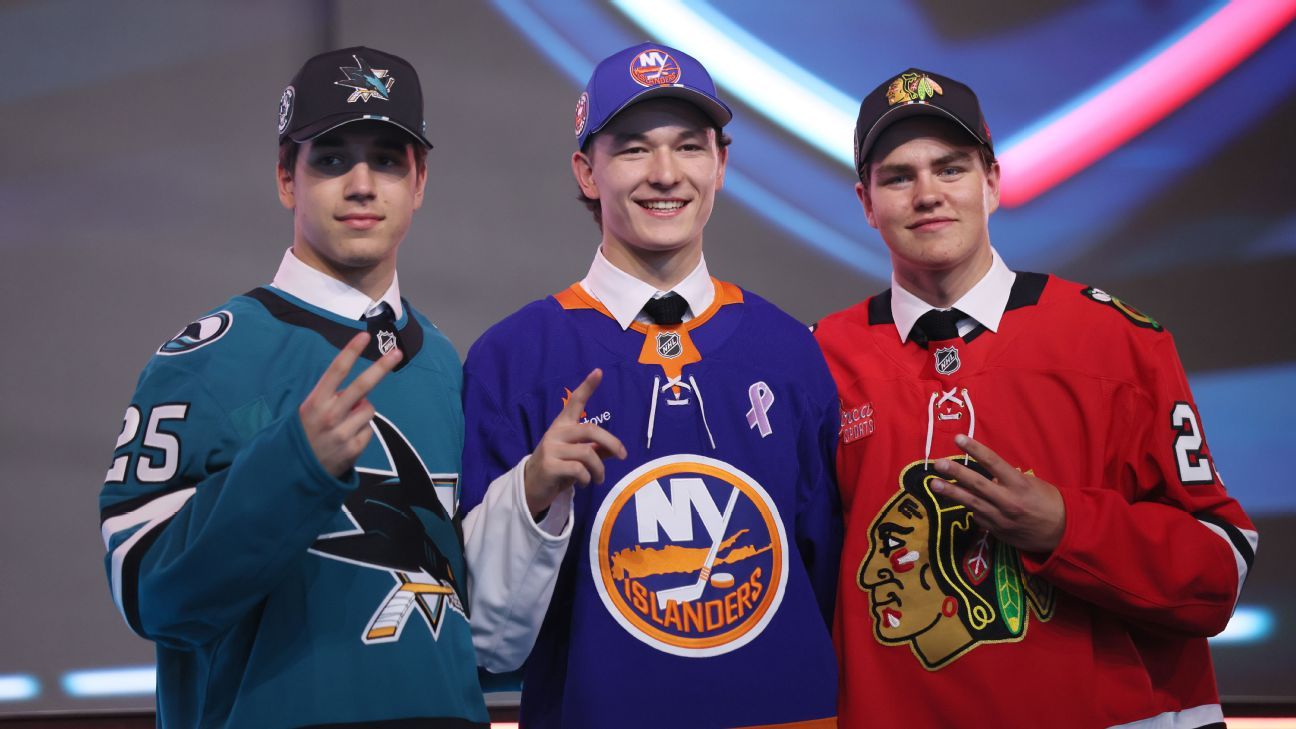
The 2025 NHL draft is taking place on Friday (Round 1) and Saturday (Rounds 2-7) at the Peacock Theater in Los Angeles.
This page will be your home for the entire event, as each pick is added below, including scouting notes and team fit analysis for the first-rounders.
More: Prospect rankings
Draft week buzz
Late-round gems
Needs for all 32 teams
Round 1

Team: Erie (OHL)
DOB: 09/05/2007 | Ht: 6-1¾ | Wt: 183 | Shot: L
2024-25 stats: GP: 17 | G: 7 | A: 15 | P: 22
Scouting notes: Schaefer is projected to become a true No. 1 cornerstone for years to come. A dynamic presence at both ends of the ice, he skates with ease and elite mobility to shut down opponents in all situations, while creating offense with quality transition play.
Executives and scouts view him as a future elite NHL defenseman and a foundational piece for a championship-caliber roster. Schaefer’s ability to control play from the blue line, play tough matchups, and run a power play — combined with the belief in his character and leadership — result in many believing that Schaefer has the tools to become a top-10 defender in the league, while wearing a letter as part of a team’s leadership group.
How he fits: After trading Noah Dobson earlier in the day, the Islanders drafted their franchise cornerstone defender. Schaefer does everything well, and is a dynamic skater with elite mobility. He will take on the toughest matchups, help the Islanders exit the zone with smooth passes and carry outs, and drive offense from the back end. He’s a future No. 1 defenseman who will log 25-28 minutes per night and run the power play.
Schaefer’s ability to dictate play from the back end is franchise-changing for the Isles. Schaefer will attend development camp next week, and it is highly likely he starts the season in the NHL lineup. Don’t be surprised if Schaefer is running the power play and logging major minutes by November.
A very emotional Schaefer hugged his family and pulled on the Isles jersey for the first time, with a cancer patch. Through tears, he shared his excitement and emotion, and gained the hearts of a lot more than just Isles fans.

Team: Saginaw (OHL)
DOB: 02/16/2007 | Ht: 6-¾ | Wt: 184 | Shot: L
2024-25 stats: GP: 65 | G: 62 | A: 72 | P: 134
Scouting notes: Granted exceptional status in the OHL in 2022, Misa delivered one of the most remarkable goal-scoring seasons in recent memory in 2024-25, netting 62 goals in just 65 games. He projects to be a top-line forward capable of consistently exceeding 90 points per season in the NHL.
Misa’s offensive instincts are elite. He processes the game at a high level and executes at top speed. Scouts believe he is NHL-ready and has the potential to become an elite top-line center. Away from the puck, Misa excels at finding soft areas in coverage and has a flair for delivering in clutch moments. His combination of high-end playmaking and goal-scoring ability makes him a constant dual threat in the offensive zone.
How he fits: The Sharks kept everyone guessing until the very last moment, but ultimately selected Misa. He is a special talent and adds a second elite two-way center to the organization. He projects as a first-line star, with dual-threat playmaking and scoring ability — notching 62 goals in 65 OHL games.
If Misa’s two-way game continues to improve, there’s a real chance the Sharks will have two centers capable of dominating play in all three zones with 2024 No. 1 pick Macklin Celebrini already in place. On the power play, Misa can facilitate, be a shooting threat and carry the puck on entries. Because of his dual-threat capabilities, he can play the bumper, the flank or down low. With this selection, the Sharks have the potential to feature the best one-two punch down the middle for years to come.

Team: Djurgarden (SWEDEN-2)
DOB: 05/07/2007 | Ht: 6-1 | Wt: 198 | Shot: L
2024-25 stats: GP: 29 | G: 11 | A: 14 | P: 25
Scouting notes: Frondell is a versatile two-way forward that plays both center and right wing. His flexibility is attractive to teams, although many believe he is most likely to reach his potential as a winger in the NHL.
Frondell is coming off one of the most productive seasons by an under-18 player in Allsvenskan history, giving him a confident projection as a first-line NHL forward. He’s a cerebral player, who picks apart defenders in one-on-one situations and defensive coverage in offensive zone play. The details of Frondell’s game are translatable, including excellent forechecking ability, willingness to attack the middle of the ice and high-end anticipation on both sides of the puck.
He has shown play-driving capabilities against men in the Allsvenskan, which has translated to the NHL for other prospects in the past. He’s projected to produce between 75-85 points per season. His style of play translates well and has executives excited about his ability to step in the league in the next 18 months.
How he fits: It was no secret that Chicago wanted to add some size up front, and Frondell is exactly that. He can play center or the wing, and brings an excellent two-way game. He confidently projects as a first-line forward that beats defenders one-on-one, drives play on both ends of the ice, and should score nearly a point per game.
He plays on the inside of the ice and has the ability to score 30-plus goals in the NHL because of his excellent shot. Frondell is a year away from playing in the NHL, and probably two or three from hitting his potential as a top-line forward who drives play. Chicago can play him behind Connor Bedard up the middle, or on Bedard’s line to capitalize on the versatility he brings.

Team: Moncton (QMJHL)
DOB: 04/11/2007 | Ht: 6-1½ | Wt: 178 | Shot: L
2024-25 stats: GP: 56 | G: 35 | A: 49 | P: 84
Scouting notes: Described as a “coach’s dream” because of his ability to take an offensive or checking assignment and execute consistently. He makes smart, simple plays, provides a physical presence on the forecheck and generally agitates and makes life difficult on defenders.
He projects to be a quality second-line center with a decent chance of becoming a first-line player. He’s cerebral, with quick hands and playmaking ability. He’s not flashy, but he’s consistently effective and makes intelligent plays with the puck. As one scouting director described “he’s the type of player you win with.” Some have quietly compared him to Patrice Bergeron and Jonathan Toews, who are lofty comparisons, to say the very least.
How he fits: The Mammoth kept everyone guessing: Would they trade or keep the pick? Ultimately, they kept the pick and selected Desnoyers. He can play in any situation as one of the best two-way players available. He’s a serial winner who plays whatever style of game required to win. If he needs to produce offense, he does. If he needs to shut down the opponent’s best, he does that too.
Utah needed some size and two-way capability to mesh with Logan Cooley, Clayton Keller and Dylan Guenther, and Desnoyers is exactly that. He’ll be NHL-ready a lot sooner than people think because his professional details are top-notch. He projects as a play-driving, two-way, second line center that the Mammoth will turn to in key situations. As noted above, there’s a lot of Jonathan Toews in Desnoyers’ game, which will excite Mammoth fans, management and coaches.

Team: Sault Ste. Marie (OHL)
DOB: 03/16/2007 | Ht: 6-0 | Wt: 178 | Shot: R
2024-25 stats: GP: 57 | G: 33 | A: 39 | P: 72
Scouting notes: A Swiss Army knife type of player who will be most effective on the wing because of his strong wall play, Martin projects as a middle-six forward capable of scoring 20 goals routinely, with upside as a second-line forward.
He’s a wrecking ball that will bring value in all three zones, on and off the puck. Martin has scouts raving about him after an excellent performance at the IIHF under-18 championship, with many opining that he could go very early in the first round. He’s a workhorse without an off switch, who brings a blend of physicality and hard skill. He’s a nightmare to contain with his brute strength, and forces defenders into precarious positions with good speed and willingness to make “winning” plays.
Several teams mentioned how impressive Martin was during interviews at the combine. Combine an attractive personality with the hard-nosed style, and it forms a rare combination that is valuable to many scouts who believe he’s the type of player teams need to win in the playoffs. Surely, his mention of Conn Smythe winner Sam Bennett as a role model grabbed attention.
How he fits: Another pick that was rumored to be on the move, the Predators kept it and selected Martin. Martin is a raw player with functional strength and projects to be a middle-six forward. He will shine as the games get tighter and more physical, and can swing momentum with a brilliant forecheck or big hit.
The hard-nosed style of game was very attractive to many teams, especially with Bennett and the Panthers’ recent success. Martin needs at least another season or two to develop his offensive game, and while the Predators did leave some skill with James Hagens and Porter Martone on the board, they believe Martin can be an impactful player for years to come.

Team: Brampton (OHL)
DOB: 10/26/2006 | Ht: 6-2¾ | Wt: 208 | Shot: R
2024-25 stats: GP: 57 | G: 37 | A: 61 | P: 98
Scouting notes: A big, cerebral forward, Martone is a dual-threat offensive player with ability to score on his own and facilitate. He projects to be a second-line scoring winger who should see top power-play minutes.
His competitive nature will make him an effective agitator as he learns to physically impose himself on opponents. He needs to hone the competitiveness and physicality to increase its effectiveness, but he is exactly the type of player teams covet because of the unique combination of offensive talent and competitive fire.
His unique combination of scoring ability, size and hard skill make him a very attractive prospect. While his most confident projection is as a top-six forward, Martone has a legitimate chance to become a top-line winger if his skating improves.
How he fits: The Flyers got a lot bigger and better with Porter Martone. Considered the smartest player in the draft by scouts, Martone is a dual-threat offensive player with excellent playmaking and shooting ability. There is an aura of competitiveness and physicality that will develop and will undoubtedly make him a fan favorite in Philly.
Martone projects to be a scoring winger who will be tough to handle as he develops his power forward game. The Flyers have some elite young players, and Martone has a big frame with elite talent, and can create offense and make special plays happen. He needs a year or two to improve his skating to fully unlock his potential as a top-six scorer, but Rick Tocchet is going to love this player.
2:00
Charles Barkley announces Porter Martone as No. 6 pick in NHL draft
NBA Hall of Famer Charles Barkley helps the Flyers select Porter Martone with the sixth pick of the NHL draft.

Team: Boston College (H-EAST)
DOB: 11/03/2006 | Ht: 5-10½ | Wt: 177 | Shot: L
2024-25 stats: GP: 37 | G: 11 | A: 26 | P: 37
Scouting notes: Hagens is projected to be a top-line center, or one of the NHL’s best second-line centers. He lacks the dynamism of Misa, opting for a highly cerebral and efficient play style. He brings a good work rate with excellent speed and passing ability that should see him effectively drive play at the NHL level. Scouts and executives are impressed with the professional details of his game (puck support, winning battles, defensive puck play), and they believe it will ease the transition to the NHL while he finds his offensive gear.
Another season at Boston College to further develop a more a dynamic offensive gear to become a top-line NHL center — the one that had scouts impressed during his NTDP season (with 102 points) — could be the remedy. After playing on one of college hockey’s top lines with Gabe Perreault (New York Rangers) and Ryan Leonard (Washington Capitals), Hagens would now be relied upon to drive his own line, create offense through his own playmaking and play a significant matchup role.
Hagens has the potential to be the complete package in the NHL. His understanding of spacing and ability to anticipate stands out among his peers. He’s smaller and slighter than other prospects, which worries some teams, but there’s a mix of Clayton Keller and Jack Hughes in him in terms of transition play and creativity.
How he fits: The organization starved for centers lucks out as Hagens falls to No. 7. He’s a highly cerebral player, with a nonstop motor, excellent speed and playmaking ability. There is little doubt he will be a play driver at the NHL level. His professional details are already top-notch with puck support, battle success, and strong defensive play.
Another year up the road at Boston College will mean Bruins fans won’t have to go far to watch their prized prospect. Hagens will step into the Bruins’ lineup as their first-line center when he is ready, and David Pastrnak will love that. Hagens has one of the highest ceilings in the draft, especially if his offense continues to develop. Bruins fans should be extremely excited to have their center of the future because he should not have been available at this point.
1:48
Adam Sandler announces Bruins pick at NHL draft
Adam Sandler gives a nod to his famous “Happy Gilmore” character to announce the Bruins picking Boston College’s James Hagens with the seventh pick.

Team: Brantford (OHL)
DOB: 06/16/2007 | Ht: 6-1¾ | Wt: 172 | Shot: R
2024-25 stats: GP: 66 | G: 32 | A: 66 | P: 98
Scouting notes: Deceptive and incredibly smooth, O’Brien projects to be a point-producing, top-six center with a chance to become a top-line center. The right-handed pivot is one of the best playmakers in the draft, creating high-danger chances with regularity; for my money, he is the best pure creator in the draft.
He consistently manipulates defenders, distributes the puck on the forehand and backhand and uses fakes that send turn defenders and goalies into pretzels. The development will come from simplifying offensive plays to eliminate turnovers caused by holding the puck for too long.
O’Brien’s shot is going to be a necessary development area if his passing is to be an elite threat in the NHL. There is risk here, because he’s slighter than other players available at the center position, but he has room to fill out over the next few years. O’Brien’s elite playmaking skills will be that much more valuable if he can add a speed gear and increase his shooting threat.
How he fits: The Kraken are collecting centers like infinity stones, but O’Brien’s ceiling was too good to pass on at No. 8. O’Brien sees the ice extraordinarily well, has elite playmaking ability and will certainly help facilitate offense. Matty Beniers and Shane Wright play a two-way game, while O’Brien and Berkly Catton can drive offense.
The Kraken are now loaded up the middle, and can easily move one or two players to the wing to round out their top six. O’Brien needs a couple of years to physically mature and improve his shot to become a dual-threat offensive player. As it is, he is more than capable of quarterbacking a power play and facilitating offense. There is no need for the Kraken to rush him, and allowing him to further develop his elite playmaking skills might improve his projection to a first-line forward who tallies a point per game in the NHL.

Team: Seattle (WHL)
DOB: 06/09/2007 | Ht: 6-5¾ | Wt: 207 | Shot: R
2024-25 stats: GP: 43 | G: 3 | A: 32 | P: 35
Scouting notes: A 6-6, right-handed defenseman with decent mobility who plays in all situations has scouts very excited. He’s very difficult to get around, routinely thwarting attackers in their tracks and killing plays. He projects as a top-four, shutdown defenseman because of his excellent stick work, mobility and transition defense. Mrtka uses his mobility to escape pressure, activate in the rush and make quality passes to the middle of the ice.
Mrtka should develop into a strong transition defender, a reliable penalty killer and efficient puck mover. He shoots the puck hard and could become more of a scoring threat if he can pick his spots to get pucks through. While everything flowed through him in Seattle, there are well-placed concerns about his lack of offense.
His size and physicality give him the tools to develop into a minute-munching, shutdown defender if his mobility continues to progress. His late birthday gives him lots of development runway to refine his skating, offensive playmaking, and physicality in all areas of the ice.
How he fits: A big, right-handed defenseman who plays a hard game, Mrtka is at least two or three years away from playing in the NHL. The Sabres have certainly been lacking players who play a hard game, and Mrtka provides that. He is a mobile skater with good puck-moving ability and projects as a shutdown defenseman at the NHL level. Mrtka’s ability to defend in transition, force attackers to the outside and kill plays is attractive.
Mrtka has a late birthday and his development runway is longer than others, giving him time to improve his playmaking, pick his spots physically and become an effective shutdown defender. There was some belief the Sabres would take a forward, and this pick raised some eyebrows, but the Sabres felt they needed a defender like Mrtka to complement Rasmus Dahlin and Owen Power.

Team: Brandon (WHL)
DOB: 10/02/2006 | Ht: 6-5¼ | Wt: 197 | Shot: R
2024-25 stats: GP: 17 | G: 10 | A: 10 | P: 20
Scouting notes: Described as “a unicorn” because he’s a 6-5 center who skates with the speed and mobility that you would expect from a smaller player, McQueen a hot topic all season. He profiles as a prototypical modern-day power forward who blends soft skill with physicality. Elite right-handed centers are rare in the NHL, and McQueen’s size and willingness to physically dictate play adds undeniable value. He has professional defensive habits that are translatable to the NHL, and unique offensive upside that is still developing given the loss of playing time due to a back injury during his draft season.
McQueen dominates the cycle game, creates offense on the rush and uses his physical gifts to dominate the cycle and protect pucks. His projection as an elite top-line center lacks confidence, due to lack of playing time from his back injury. Without the injury, we might be discussing McQueen near the top of this draft class because his package of skating, skill and physical gifts are rare, and the type of toolbox of which executives dream.
He is a textbook case of high-risk, high-reward player; however, his performance at the scouting combine went along to proving his back injury had healed completely. Playing against tougher competition, where McQueen will be forced to develop his ability to protect himself, the puck control and ability to create offense against bigger bodies will be important. If developed without setback, he could become a two-way force in the NHL for years to come.
How he fits: The Ducks swung the bat, and are hoping McQueen is a home run for them at No. 10. Had it not been for injury, there’s a very real chance that McQueen gets taken in the top five. McQueen moves with the speed and agility of a much smaller player. He can dictate play physically, drive play at both ends of the ice and possesses unique offensive upside.
Anaheim has some high-end forwards — and McQueen likely has the highest upside of them all. He can dominate off the rush, on the cycle, and at the net front. The combination of McQueen’s physical gifts, skill and skating make him an easily projectable power forward who changes the course of games. If he can remain healthy, get stronger and improve his puck-protection skills, the Ducks have a special player.
Patience will be key as McQueen needs a few years to develop his skill set, but if he hits his ceiling, he’s going to be a dominant two-way force in the NHL.

Team: Calgary (WHL)
DOB: 04/19/2007 | Ht: 5-10 | Wt: 176 | Shot: R
2024-25 stats: GP: 65 | G: 35 | A: 64 | P: 99
Scouting notes: Kindel is a scoring machine. Following a 60-point rookie campaign in the WHL in 2023-24, he vaulted into elite status this season, finishing seventh in overall scoring, and was excellent at even strength.
Though undersized, Kindel blends pace, vision and quality instincts, and he projects to be a middle-six winger with two-way ability. Kindel’s motor is relentless, which makes up for his lack of speed, and enables him to weave through traffic and execute give-and-go’s with ease. A dual-threat attacker, he pairs an accurate shot with dangerous passing ability. His elite hockey sense allows him to consistently outsmart opponents and set teammates up with creative plays in dangerous areas with time and space, while playing positionally sound hockey off the puck.
Defensively and on the forecheck, Kindel leverages his intelligence, anticipation and effort to win battles despite size disadvantages. He’ll need to refine and improve his skating posture and puck control, while adding another speed gear to succeed in the NHL.
While the potential exists for Kindel to a top-six NHL player, he is more likely to find himself in the middle-six as a complementary piece.
How he fits: Kindel is a facilitator of offense, a brilliant playmaker and somewhat of a surprise at No. 11. Kindel brings high-end hockey sense to identify opportunities to set up teammates in space. He’s undersized, but his package of speed, playmaking and relentless motor should translate well to the NHL.
Kindel’s ceiling is a second-line center who facilitates for his teammates and drives play. If he doesn’t, he’s likely to be a middle-six, secondary producer who plays on the second power-play unit. The Penguins need players who are cerebral, skate well and drive offense — and are certainly swinging on Kindel’s ceiling. If he grows an inch or two as he develops over the next two years, the comparable to Brayden Point is a good one given the similarities in skating, cerebral play, and driving play at that size.

Team: Windsor (OHL)
DOB: 01/12/2007 | Ht: 6-4¼ | Wt: 185 | Shot: L
2024-25 stats: GP: 65 | G: 25 | A: 39 | P: 64
Scouting notes: Nesbitt is an intelligent, two-way center whose game is rooted in competitiveness, defensive reliability, and off-puck hockey IQ. He excels defensively by using his 6-4 frame to break up plays with physical engagement and smart stick positioning to pick off pucks. His hockey sense consistently places him in strong positions in all three zones, allowing him to create turnovers and execute quick passes to create dangerous chances off those turnovers.
His offensive upside hinges on his skating, which is a concern. His stiff skating stride and lack of demonstrated flexibility at the combine might limit how much he can improve. Despite flashes of skill, he struggles to maneuver past defenders, and his inconsistent puck handling under pressure often disrupts his playmaking.
Nesbitt showed improvement throughout the season, leveraging his size offensively and initiating more contact more consistently. If these improvements continue, and he’s able to improve his skating stride, he projects confidently as a dependable middle-six center who can anchor a defensive line and support skilled players higher up the lineup.
How he fits: The Flyers traded with their state rival the Penguins to select Nesbitt. He’s a high-floor player who probably tops out as a third-line center. At his height, he has been described as a “hard to play against” center who plays a throwback game, which fits with the style the Flyers want to play.
There were a lot of rumors this week that Nesbitt would get taken early because of his positional value, blend of size, hard skill and hockey sense. A very intelligent player who executes quality passes, he plays a reliable game. His skating stride will be the ultimate determining factor in his NHL ceiling. If he adds mobility and an extra gear, there’s more offense to unlock, but the focus will be his ability to check. He needs two or three years to develop, but Nesbitt had one of the most confident, low-volatility projections in the draft class as a third-line center.

Team: Everett (WHL)
DOB: 11/04/2006 | Ht: 6-0 | Wt: 179 | Shot: L
2024-25 stats: GP: 56 | G: 40 | A: 42 | P: 82
Scouting notes: Bear is the type of player that a team looking for high-end instincts and playmaking covet. Before a season-ending injury in March, Bear was one of the CHL’s most dangerous offensive players and a reliable defensive forward. He’s versatile, in that he plays center and the wing, and projects as a 65- to 75-point, second-line player, most likely on the wing.
He’s a quality playmaker using different passes to create advantages in dangerous areas. His ability to manipulate defenders and create space for teammates while pulling coverage towards him should translate well in the NHL. He’s got good hands in tight spaces, which make him a threat around the net, and is one of the best offensive facilitators in the draft class.
On top of his offensive gifts, Bear’s defensive play makes him a quality two-way player. His stick positioning allows him to disrupt passes, and he’s a tenacious forechecker who tracks well on the backcheck and finishes hits. His skating posture needs to be more upright to allow him to develop a more explosive stride to take advantage of his offensive skills in transition, but the instincts and execution of plays already exist.
Bear is a good mix of soft and hard skill with projectable traits on both sides of the puck, and he is the type of player who should thrive in a matchup role while contributing offensively.
How he fits: There’s a lot to like about how Bear plays the game, and I’m a believer that there is more offense to give. He has elite hockey sense that he relies on to impact the game on both ends of the ice. A projection as a second-line, two-way player who scores close to 75 points per season should be very exciting for Red Wings fans.
His playmaking ability makes up for a lack of speed, and should fit nicely into what the Red Wings have up front. He’s a unique blend of soft and hard skill that will be reliable in all situations. He can win puck battles, get under the skin of opponents and make a difference in all areas of the ice. He’ll need two or three years to improve his skating and fill out physically, but when he’s ready, he’ll slide right into the Wings’ middle six as an impactful player.

Team: Tri-City (WHL)
DOB: 05/13/2007 | Ht: 6-3¼ | Wt: 195 | Shot: L
2024-25 stats: GP: 68 | G: 11 | A: 43 | P: 54
Scouting notes: Smith is a big, physical defenseman with untapped offensive ability. He possesses all the qualities of a top-four matchup guy. He defends the rush well, closes gaps and steers the play in transition, making him one of the best neutral-zone, transition defenders in the class. Given the importance of transition defense in a matchup role, Smith has a real chance to the guy coaches rely upon to play heavy minutes against the best players.
His blend of skating, size and poise with an offensive game that progressed positively as the season wore on makes me a believer that there is more to give, and playing at Penn State next season should help it along.
Smith stands 6-3, and executives love the simplicity of his game, reading pressure, disrupting plays and making effective passes to exit the zone. He lacks explosive skating, and the consistent creativity required to be a quality offensive contributor at the NHL level, but his reads are there to be a plus transition player and join the rush as a support player.
Smith’s development from here will be about using his excellent mobility to prevent rush offense and becoming a more consistent offensive threat with better puck management. If Smith can drive play on both sides of the puck in transition and become a power-play threat, there’s a real chance he becomes a No. 2 defender at the NHL level.
How he fits: The Blue Jackets tugged on everyone’s heartstrings by having Meredith Gaudreau, the wife of the late Johnny Gaudreau, select Smith. The Penn State commit has untapped offensive potential to blend with his package of physicality, size and skating. He’s poised with the puck, makes quality breakout passes and influences the play. Defensively, he’s excellent in transition, closing gaps and forcing players to the perimeter.
The Blue Jackets needed a defenseman, and getting Smith outside the top 12 is great value. He should reliably play a matchup role on the second pair, and has the potential to play in a No. 2 role. Smith’s development will be about leveraging his mobility to improve his offensive game, and become a more consistent threat with the puck in the offensive zone.
2:50
Johnny Gaudreau’s wife announces the Blue Jackets’ draft pick
Meredith Gaudreau, Johnny Gaudreau’s widow, joins the NHL draft to announce the Blue Jackets selecting Jackson Smith with the 14th pick.

Team: Seattle (WHL)
DOB: 02/09/2007 | Ht: 5-11¼ | Wt: 183 | Shot: R
2024-25 stats: GP: 60 | G: 26 | A: 37 | P: 63
Scouting notes: Cootes lacks explosive offense, but with some development of his shooting mechanics, he could become a 60-point, two-way center. Scouts love how consistently he moves his feet throughout his shifts, his drive to play through the middle of the ice and his ability to create advantages for himself with his skating and compete level.
His ability to create space for his teammates and move the puck to advantageous areas of the ice is highly translatable. He’s proactive with his contact, moves the puck to the middle of the ice and is reliable on both sides of the puck, in every area of the ice.
A strong skater and leader, his floor is likely a third-line checking center, but there’s potential for him to become a two-way, second-line center.
How he fits: The Canucks need centers, as president of hockey operations Jim Rutherford has stated numerous times this offseason. It was thought the Canucks might select the falling Viktor Eklund, but instead they addressed an organizational need by drafting Cootes.
He’s an-all situations player who can comfortably play a middle-six role, with a floor as a high-energy, third-line center. He’s a quality two-way player with a nonstop motor. The Canucks love his compete level, his willingness to drive the middle of the ice and a tenacious quality to his game.
Cootes has the ability to create space for his teammates, be reliable on both ends of the ice and outskate opponents. There is reason to believe he will develop more offensively. If he does, there’s a chance he becomes a second-line, play-driving center.

Team: Djurgarden (SWEDEN-2)
DOB: 10/03/2006 | Ht: 5-11 | Wt: 161 | Shot: R
2024-25 stats: GP: 42 | G: 19 | A: 12 | P: 31
Scouting notes: Eklund projects as a top-six forward with a good chance of becoming a top-line contributor. Despite concerns about his size, Eklund’s style of play is very translatable to the NHL. He plays a lot bigger than his measurements suggest, and there is room to add strength. Should he grow, which has happened to other prospects in the past, Eklund’s projection becomes more confident as a 70-point producer with a high-end motor and excellent forechecking capability.
Eklund is excellent in transition and attacks defenders with speed and fearlessness, darting to the inside, and positioning his body to win or protect pucks. His smaller size has forced him to learn how to protect the puck with excellent body positioning. If he develops a bigger, stronger frame, those skills will make him even more difficult to defend in the offensive zone.
His off-puck play is mature, and will quickly earn the trust of NHL coaches. Eklund has the potential to be a difference-maker in a second-line role, and his blend of hard-nosed play with soft skill should translate more seamlessly than other players.
How he fits: With their second pick in the first round, the Isles got tremendous value by selecting Eklund. He plays bigger than his frame with excellent forechecking, hard skill and puck-protection skills. He uses above-average speed to attack the middle of the ice, creating offense in transition and below the circles.
Eklund has a motor without an off switch, and competitive fire to burn. The combination of hard-nosed play and soft skill should allow Eklund’s game to translate seamlessly to the NHL. He should fill out physically, and there is a real chance he becomes a difference maker in the top six on the wing. The ceiling for Eklund is higher than any other player who was available in this spot, and he might be ready sooner than some expect. Isles fans should be extremely excited with this pick.

Team: Barrie (OHL)
DOB: 09/21/2006 | Ht: 6-1½ | Wt: 196 | Shot: L
2024-25 stats: GP: 64 | G: 26 | A: 33 | P: 59
Scouting notes: His projection as a No. 4/5 defender sees him below other players with higher upside. Aitcheson plays with all kinds of truculence and aggression, while possessing an aura of confidence on and off the puck. He’s got all the makings of being a complete menace who plays tough minutes as a No. 4 defender.
Whether it is a preseason game or the playoffs, Aitcheson plays the same rough style, and is unafraid of lowering the boom on opponents. He needs to pick his spots better to avoid unnecessary penalties, but he’s the type of player that requires opponents to be aware when he’s on the ice. Scouts see him as hard-nosed, two-way defender with significant bite who can be a momentum-shifter with his physical presence.
He needs development time, as his skating and playmaking are very raw, but the competitive attributes and his development curve this season are very promising. Aitcheson’s offensive involvement developed as the season progressed, rotating with his teammates, diving down towards the high-danger area and becoming more dangerous with open ice.
He’s likely two or three years away from being ready to step in. But when he does, he’s exactly the type of defender every coach and GM want on their team.
How he fits: With their third selection of the first round, the Islanders selected a lot of nastiness in Aitcheson. One of the meanest, aggressive defensemen in the draft, Aitcheson is going to be a nightmare to play against. He’s very raw, and has untapped offensive potential. The competitive attributes make Aitcheson’s playstyle a throwback, and he is likely to become a fan favorite on the island. He can change a game’s momentum with a big hit, but also showed the ability to contribute offensively as the season progressed.
His skating and playmaking are the biggest areas of development, but even if he doesn’t find more than 30 points at the NHL level, Aitcheson is the type of defenseman with whom you win a lot of games. He makes life difficult for opponents, defends his teammates, sacrifices his body to win and is relentless in puck battles. At his ceiling, Aitcheson could become a second-pairing matchup defender who makes forwards think twice before engaging in a puck battle or cutting across the blue line with their head down.

Team: Victoria (WHL)
DOB: 04/06/2007 | Ht: 5-10½ | Wt: 183 | Shot: L
2024-25 stats: GP: 62 | G: 26 | A: 66 | P: 92
Scouting notes: The two-way center brings an excellent mix of hockey sense, playmaking and creativity to be a middle-six contributor capable of consistently producing 60 points. He lacks elite skating, but his combine results raised eyebrows — tying Frondell for tops in VO2 max. While that isn’t indictive of NHL success, it shows a particular dedication to conditioning, and those in NHL circles pay attention to those results.
Reschny is smaller, and relies on his cerebral approach and excellent passing abilities to create advantage all over the ice. He processes the game better than many in the draft class, allowing him to manage pressure and put himself in better puck-protection positions.
Defensively, Reschny’s instincts result in positionally sound play, regularly playing above the puck, disrupting passes, and communicating assignment switches. He’s got the potential to be a great two-way complementary center that creates offense without separating speed. His reads will almost surely see him play a penalty-killing role and someone who is relied upon when his team is holding a lead.
How he fits: The Flames needed a center and they got their guy, drafting Reschny. He is a quality two-way center with creative playmaking abilities and high-end hockey sense. He picks apart defensive coverage with those abilities, consistently putting his team in dangerous areas to score. Off the puck, he’s positionally sound, reliable defensively and he should be a secondary penalty killer.
Reschny’s speed will need to develop, but his ability to process the game better than most players will help him be in the right spots, identify scoring opportunities and drive play. He’ll need two years in the NCAA before he’s ready, but when he is, he’s likely to slot in to a middle-six role and provide value on both ends of the ice.

Team: Blainville-Boisbriand (QMJHL)
DOB: 11/25/2006 | Ht: 6-1 | Wt: 191 | Shot: R
2024-25 stats: GP: 62 | G: 46 | A: 43 | P: 89
Scouting notes: Carbonneau possesses an offensive toolbox that teams covet, including powerful skating and eye-popping creativity. He projects as a second-line scoring forward with significant variance and is likely to end up as a middle-six player who thrives against secondary matchups. Carbonneau can drive offense with his playmaking and shooting ability and plays a well-rounded offensive game that includes playing through contact, excellent puckhandling skills and above-average skating.
As is the case with any player who possess incredible upside, there is inherent risk. He has a physically mature body, and will need to adjust to the speed of the professional game. He thrives when given time and space, and his growth will come from learning to simplify his offensive play and make better decisions with the puck. There are tools to become a very effective power forward in the NHL who can score 25 goals if he adds a cerebral component to his game.
How he fits: Carbonneau is a high-upside, dual-threat player who drives the middle of the ice and has an excellent shot. Off the puck, he finds quiet areas on the inside of the ice and takes advantage of scoring opportunities. Carbonneau has the size and physicality to become a power forward in the NHL, and should fit nicely on the second line and first power-play unit.
He’s a raw player who will need to develop his skating to take advantage of his offensive toolbox, but the upside is very high. Carbonneau’s blend of size, fearless play, creativity and elite shooting ability bode well for his NHL projection. If the Blues are patient, Carbonneau should become a quality power forward in three to four years.

Team: CSKA Jr. (RUSSIA-JR.)
DOB: 01/22/2007 | Ht: 6-0 | Wt: 207 | Catches: L
2024-25 stats: GP: 37 | Mins: 2,195 | GAA: 1.75 | SV%: 0.942 | SO: 3
How he fits: With their second pick of the night, the Blue Jackets raised a lot of eyebrows selecting Andreyanov. Many had expected them to take a second defenseman, but they identified the Russian goalie as their guy.
He’s athletic, and plays an aggressive style, cutting angles down and making life difficult for shooters. He’s a battler, fighting through screens, managing his movements with traffic at the net front, and freezing the puck without sacrificing position. His rebound control needs to improve, but the Blue Jackets like his toolbox and his ability to come up with key saves at critical times.
He could be a reliable NHL backup, with some potential to become a 1B tandem goaltender if his rebound control improves. This is a big bet in the first round, one that the Blue Jackets hope pays off.

Team: Kitchener (OHL)
DOB: 04/08/2007 | Ht: 5-11¾ | Wt: 193 | Shot: L
2024-25 stats: GP: 67 | G: 14 | A: 40 | P: 54
Scouting notes: There’s a lot to love about Reid’s game — and a lot of varying opinions. Some scouts see him as a top-15 value, others see him as a mid-20s value, and it all hinges on their belief in his offensive game. Reid is a play driver from the back end with excellent puck-moving skills and excellent skating. He flashes high-end offensive ability in the form of setups and moving to find and create passing lanes to high-danger areas; however, his shot will need to become more of a threat to avoid his distribution being neutralized in the NHL.
In transition, he’s one of the best on both sides of the ice. His smooth puck retrievals — where he constantly shoulder checks and scans to avoid pressure — led to efficient breakouts. When under duress, he uses elite edgework to escape and shake pressure, following with a quick outlet pass to beat the forecheck.
The consensus belief is that he’s a middle-pairing, transition defender who can turn into a bona fide No. 3 if he develops his offense and grows an inch or two; currently he’s listed at 5-11.
How he fits: Nashville traded up to get Reid, and he’s going to be a stalwart on the blue line. An excellent transition defenseman, Reid makes a quality first pass, and has the potential to drive offense from the back end. Reid’s terrific skating ability allows him to escape forecheckers and join the rush. Defensively, Reid has good gap control, uses his skating to close attackers early and match speed to limit dangerous chances.
He’s going to be a high-end transition defender who could become a 50-plus point producer if his offensive development continues. His elite skating ability allows him to be patient, not get caught doing too much and he’s rarely out of position. He’s two or three years away from making an impact at the NHL level, but when he does, he’ll be a quality second-pairing defender on both ends of the ice.

Team: Rouyn-Noranda (QMJHL)
DOB: 10/03/2006 | Ht: 6-1¾ | Wt: 187 | Shot: L
2024-25 stats: GP: 64 | G: 28 | A: 55 | P: 83
Scouting notes: Zonnon is a relentless and detail-oriented two-way forward who has carved out a reputation as one of the CHL’s hardest-working players. With an 83-point breakout campaign in his first full-time season at center, Zonnon combined a high-end motor, raw but effective playmaking and relentless puck pursuit that allowed him to be a play driver in all three zones. He excels on the forecheck, pressuring defenders into rushed decisions, winning battles and moving pucks to teammates in scoring areas.
Offensively, he makes good reads under pressure, threading pucks through tight lanes and consistently puts his team in advantageous positions. His ability to support defensively, facilitate transitions and physically impose himself makes him ideal the type of forward who teams want in the playoffs.
His skating remains a limiting factor, and he’ll need to improve his agility and posture to reach his offensive ceiling. If Zonnon can refine his stride and continue to develop his playmaking, he projects as a middle-six driver who blends tenacity and has the makings of a valuable third-liner whom playoff teams covet.
How he fits: With their second selection of the first round, the Penguins selected Zonnon, a high-energy, relentless winger. He has elite details, supports the puck, wins puck battles, forces turnovers on the forecheck and finds his teammates in space. Zonnon makes sound decisions with the puck under pressure, facilitates offense and is reliable defensively. His nonstop motor and willingness to get to the hard areas of the ice should help him score at the net front, win pucks back to extend offensive zone time and make life easier for his linemates.
His skating will determine where in the lineup he plays, but his floor as a bottom-six competitive forward who can penalty kill and forecheck is a confident one. If Zonnon’s skating improves over the next two to three years, he should be able to drive play in a middle-six role with tenacity and reliability.

Team: Wisconsin (BIG10)
DOB: 10/14/2006 | Ht: 6-2¼ | Wt: 192 | Shot: R
2024-25 stats: GP: 32 | G: 2 | A: 10 | P: 12
Scouting notes: The 6-2 defender projects to become a second-pair blueliner that excels in transition. He is one of the best neutral-zone defenders and puck movers in the draft, who steadily improved as a true freshman in the NCAA. His puck retrievals, breakout passes and offensive-zone passes consistently put his team in more advantageous attacking positions. Being a right-handed defender with excellent mobility and an easily translatable game makes Hensler a very attractive prospect in this class.
The are concerns among NHL scouts related to Hensler’s offensive abilities and how he might fare in the NHL. However, Hensler showed flashes in the back half of the NCAA season, drawing defenders in and making slick plays for high-danger scoring opportunities. He’s unlikely to become a 60-point defender, but 35-45 points as a steady transition defender who plays a shutdown role seems to be the appropriate projection.
His NHL-ready frame is a plus, and will only improve throughout his collegiate career, which is likely to be another two seasons.
How he fits: The Sens extracted tremendous value by getting Hensler at No. 23. As one of the younger players in college hockey last season, Hensler became an impactful player once he adjusted to that level. His skating and mobility are high-end, allowing him to shut opponents down in transition, kill plays and be a reliable defensive presence. One of the best neutral-zone defenders in the draft, Hensler’s gap control forces dump-ins, and his skating allows him to turn and retrieve those forced dump-ins with ease.
He showed flashes of higher-end offense toward the end of the season, making quality plays to create high-danger chances. He’s physically ready for the NHL, but will benefit from more NCAA development to improve his offensive play and solidify his defensive game. When he’s ready, he could become a great partner for Jake Sanderson or play secondary matchups in the middle pairing.

Team: Michigan (BIG10)
DOB: 01/23/2007 | Ht: 6-4¾ | Wt: 190 | Shot: L
2024-25 stats: GP: 18 | G: 4 | A: 6 | P: 10
Scouting notes: The son of former NHLer Shawn Horcoff, Will projects as a defensively reliable third-line center with size, strength and strong off-puck instincts. At nearly 6-5, he’s a disruptive force in his own zone, using his range and physicality to pressure puck attackers and cause turnovers.
Offensively, he facilitates with smart passes and uses his size to play with contact and protect the puck. He’ll need to develop his skating from a speed and mobility perspective to grow offensively. If he adds a step with some explosiveness and fills out his frame, Horcoff could become a physically imposing, two-way pivot in a bottom-six NHL role who plays against secondary matchups.
How he fits: The Penguins traded up seven spots to make their third selection of the first round in Horcoff. The youngest player in college hockey this season was a steady riser in the back half of the campaign. A bit of a late bloomer, Horcoff has room to fill out his frame, and plays a quality two-way game. Horcoff drives the net and converts chances better than almost any other draft-eligible player, a scoring skill that will translate well to the NHL level.
He projects as a third-line center who uses physicality to separate players from pucks, protect pucks and drive to the middle of the ice. Horcoff will need a few years to develop in the NCAA, and if he can add some speed and explosiveness, there is more offensive potential as a power forward.

Team: Muskegon (USHL)
DOB: 04/06/2007 | Ht: 6-5¼ | Wt: 187 | Shot: R
2024-25 stats: GP: 61 | G: 19 | A: 23 | P: 42
Scouting notes: Nestrašil is a high-upside power forward who projects as a top-six NHL winger if his development continues on its current path.
He is a unique blend of above-average puck skill and playmaking with size, motor and punishing physical play. He excels with give-and-go’s, attacking off the wall, and creating space in traffic. He consistently moves the puck through carries or passes to the middle of the ice, creating more threatening opportunities.
He is raw and somewhat erratic with his reads and timing; his continued improvement and physical toolkit give him legitimate upside. If he becomes a more consistent threat, he’s a second-line force; if not, his defensive value and intensity still project a role as a physical, bottom-six winger.
How he fits: With their second selection in the first round, Chicago selected Nestrašil. I had connected him to the Blackhawks in the final mock draft, given the organization’s edict to draft quality skaters with high-end skill.
Nestrašil has high upside as a power forward in the top six, and brings a package of size, puck skill and playmaking. Another player with a high-end motor, Nestrašil plays well off teammates, attacks off the wall and bullies his way to the middle of the ice.
He has a projectable physical game that will create space for his teammates, and he can separate opponents from pucks and be reliable defensively. He’s a few years away from being ready, but there’s a lot to be excited about with the blend of size, physicality, playmaking and skill.

Team: Madison (USHL)
DOB: 11/08/2006 | Ht: 6-0 | Wt: 170 | Shot: R
2024-25 stats: GP: 58 | G: 31 | A: 37 | P: 68
Scouting notes: One of the most skilled and creative forwards in the draft. Some scouts had Lee ranked in the late teens because of their belief in his upside.
Lee is a dynamic offensive player who consistently cuts through defensive coverage with elite puckhandling and deceptive passes. His one-timer is one of the best in the draft class. With a full complement of high-end tools, Lee has a rare ability to create offense in tight quarters with limited space, and he stood out amongst his USHL peers. He manipulates defenders and delivers elite passes under pressure. He consistently makes translatable plays like one-touch breakouts, fake receptions, and quick releases in scoring areas. As the season progressed, he showed a willingness to forecheck, battle and apply pressure defensively.
The glaring question is his skating. His stride is stiff and lacks explosiveness. Lee will need major strides in mobility to maximize his offensive toolkit at the NHL level. That being said, if he adds a step or two to pair with his skill, Lee has the skill to become a creative, middle-six playmaker with top-six upside.
How he fits: Nashville used its third selection in the first round to select one of the highest-upside players left on the board. Lee is extraordinarily skilled, and is one of the best pure creators in the draft class. A real dynamic player who is a dual threat with his playmaking and elite shooting ability. He creates offense out of nothing, can play in tight spaces, and make defenders look silly.
His play away from the puck developed as the season progressed. To reach his ceiling as a top-six, dynamic offensive threat, Lee needs to add speed and explosiveness. The ability to execute high-skill plays at speed will make or break him as a prospect in the top six. If he hits, the Preds have a special player — but patience is critical. I love this swing from the Preds, as it is exactly the type of player they need in their system.

Team: Moose Jaw (WHL)
DOB: 12/12/2006 | Ht: 6-4¼ | Wt: 190 | Shot: L
2024-25 stats: GP: 47 | G: 27 | A: 31 | P: 58
Scouting notes: The 6-4 left winger has translatable scoring ability, and excellent speed for his size. With room to fill out his frame, Lakovic is an attractive prospect.
He attacks with linear crossovers using his big frame to protect the puck, and makes plays using good deception. He has the potential to be a dual-threat winger at the NHL level if his passing translates the way many believe his shooting will. Lakovic projects to be a middle-six winger with fair confidence because of his scoring ability, speed and size, but there is a chance he becomes a second-line scoring threat.
Lakovic’s development will come on the physical side. While he is supremely skilled, he needs to lean on defenders and force his way to the middle of the ice to take advantage of his quick hands and shot. If he does, he becomes a significantly more dangerous player, as he’ll be a threat in transition and off the cycle. That is certainly a developable skill that translates to any level, and combined with quality offensive instincts and skill, could see Lakovic become a dual-threat, 65-point winger.
How he fits: The Capitals selected Lakovic, a big forward with an excellent shot and quality skating. Lakovic has NHL scoring ability and speed. If he can fill out his frame, should be able to get to the hard areas of the ice with ease. He understands how to protect the puck and play connected with his teammates.
He projects as a middle-six winger with dual-threat ability, and would certainly benefit from adding some physicality to his playstyle to become a skilled power forward. He’ll have Tom Wilson to learn from, and the Capitals have time to develop Lakovic into the complementary scorer he is capable of becoming. This is excellent value for the Capitals at the end of the first round because Lakovic could be ready to contribute in two or three years.

28. Winnipeg Jets: Sascha Boumedienne, D
Team: Boston University (H-EAST)
DOB: 01/17/2007 | Ht: 6-1 | Wt: 175 | Shot: L
2024-25 stats: GP: 40 | G: 3 | A: 10 | P: 13
Scouting notes: One of the most discussed and debated defenders in the draft, Boumedienne projects as a second-pair, two-way defender.
Already known as a brilliant breakout passer with a heavy slap shot and strong stick play, Boumedienne’s defensive game evolved noticeably at Boston University. Buoyed by steadily improving his skating weaknesses, particularly his agility and edge work, he looked the part of a modern shutdown defenseman, specifically in transition. He developed greater stability, enabling more effective gap control and quicker pivots. Proactive reads, strong positioning, physicality and effective disruption of passing lanes allowed his defensive game to blossom.
While his offensive game remains primarily rush-based rather than in the offensive zone, Boumedienne’s willingness to experiment with fakes and deception improved his transition impact significantly. The volatility of his projection remains high, but Boumedienne’s substantial in-season growth, defensive reliability and refined skating offer realistic upside as an effective second-pair, two-way defender at the NHL level who can produce secondary offense.
How he fits: The Jets drafted a fantastic breakout passer in Boumedienne, who should blossom into a quality transition defender. He possesses a quality slap shot, an evolved defensive game and excellent transition play. His skating looks smooth, and still has room to improve in terms of edge work and stability. If it does, he’ll become even more difficult to beat in transition and able to join the rush offensively. He’s strong positionally, engaged physically and kills plays.
He’ll need two or three years before he’s NHL-ready, but the potential to become a second power-play quarterback and middle-pairing, secondary-matchup player is tangible. At a minimum, he’ll provide quality breakout passes, good transition defense and a threatening slapshot.

Team: Edina (HIGH-MN)
DOB: 08/03/2007 | Ht: 6-5¾ | Wt: 215 | Shot: R
2024-25 stats: GP: 31 | G: 27 | A: 22 | P: 49
Scouting notes: Without a doubt, the best overall athlete in the draft class. A high school quarterback with legitimate college football potential and a hockey player who went in the first round of the NHL draft does not come around too often.
West possesses rare mobility, physical tools and intriguing upside. A natural shooter and smooth skater, his production on the Minnesota High School circuit at Edina High was impressive. When he stepped into the USHL, his development hit warp speed.
For obvious reasons, West is very raw as a prospect. He shows flashes of skill, an immovable net-front presence and growing physical engagement. Given his rawness, he will need to develop his puck control, positioning and decision-making. However, he will be able to rely on his QB scanning skills to help develop his decision-making in hockey. With continued development, there is a real chance he becomes a middle-six NHL power forward. The pure raw ability of this elite athlete has executives and scouts very excited.
How he fits: Chicago traded up to make a third selection in the first round, grabbing West, a quarterback and hockey player from Edina High School. One of the youngest players in the draft, West is one of the best pure athlete in the class, elite at two sports.
He has a very long development runway and won’t play in the USHL until after his football season. He combines smooth skating, a strong net-front presence and good play facilitation. West is very raw, with room to develop his puck skill, positioning and decision-making. His spatial awareness is excellent and will allow him to identify open space, bully his way to the middle of the ice and create offense. He’s still a long way away, but if he hits, West has a chance to be a powerful middle-six forward who can score and facilitate offense.

Team: Prince George (WHL)
DOB: 11/27/2006 | Ht: 6-5¼ | Wt: 190 | Catches: R
2024-25 stats: GP: 51 | Mins: 2964 | GAA: 3 | SV%: 0.901 | SO: 0
Scouting notes: Ravensbergen projects a composed, confident demeanor, with a confident projection as a starting NHL goaltender who can handle a significant workload.
At 6-5, he leverages size, elite anticipation and crisp lateral agility, consistently positioning himself perfectly to deny shooters without unnecessary flash. He tracks the puck a level above his peers, which allows him to confidently challenge shooters and cut angles effectively. He is particularly vulnerable through the five-hole, which isn’t atypical for large goalies who hover sticks above the ice. As he develops and refines his technique, this weakness should be corrected long before he reaches the NHL.
A reliable backstop for Prince George, Ravensbergen’s .901 save percentage stands out even more when considering the high-danger chances he regularly faced. His rebound control is well above average, and he has an above-average glove hand. He regularly has his blocker angled well, enabling him to direct shots safely away from danger.
It is likely that Ravensbergen becomes a platoon starter until his mid-20s, when he is capable of become a full-time NHL starter who plays 60-65 games per season.
How he fits: Some thought the Sharks would take a defenseman after getting Misa with the No. 2 pick, but instead they added to their goaltending group with Ravensbergen. There is a very real possibility that Ravensbergen and Yaroslav Askarov develop into one of the best goaltending tandems in the NHL.
Ravensbergen is a southpaw goaltender. He’s composed in his movements, reads the play to limit erratic movement, and challenges shooters effectively. He is the best puck tracker in the draft, finding pucks in traffic, moving efficiently to thwart opportunities and control rebounds. Goaltending development is not linear, and much more difficult to predict, but Ravensbergen should find himself in strong contention for Team Canada at the IIHF world junior championship before turning professional.

Team: London (OHL)
DOB: 02/09/2007 | Ht: 6-1¾ | Wt: 203 | Shot: R
2024-25 stats: GP: 67 | G: 10 | A: 32 | P: 42
Scouting notes: Brzustewicz is the next prospect from the factory that is the London Knights. The blueliner projects as a steady, mobile transition defender with the potential to grow into a No. 4 or 5 NHL blueliner.
A right-handed shot with a strong defensive foundation, he maintains good gap control, moves the puck very well and supports plays while remaining positionally sound. In an elevated role, his offensive creativity developed dramatically. He jumped into the rush, evaded forecheckers and created scoring chances with quality passes to the slot.
If he continues to develop his confidence and play-driving ability, Brzustewicz could evolve into a reliable second-pairing defender. Without that growth, he still holds value as a depth puck mover with a good defensive foundation.
How he fits: The Kings addressed a significant area of need by drafting Brzustewicz. A right-shot defender with quality mobility and reliable transition play. As the season progressed, Brzustewicz facilitated offense, using his skating to attack open space. He makes a good first pass that puts his teammates in position to attack off the rush. Once he moves the puck, he jumps in the play, supports as a secondary rush attacker and can shake defenders to create scoring chances.
He’ll be the go-to guy in London next season, with opportunities to play a matchup role and run the power play, both of which will expedite his development. He’s likely three years away from becoming an NHL contributor but should become a reliable middle-pairing defender.

Team: Arizona State (NCHC)
DOB: 01/10/2007 | Ht: 5-10 | Wt: 172 | Shot: L
2024-25 stats: GP: 35 | G: 13 | A: 9 | P: 22
Scouting notes: Potter is a dynamic skater who is the fastest straight-line skater in the draft class, and his explosive mobility ranks among the draft’s best. Making an uncommon jump from the NTDP’s under-17 team straight to NCAA play, Potter displayed elite acceleration and agility, effortlessly shifting from stride to crossover and cutting sharply through defenders. Initially reliant on raw skill, Potter often avoided physical battles and forced “hope plays,” limiting his effectiveness in the first half of the NCAA season.
Potter’s evolution in the second half of the season elevated his game dramatically, and it was impossible not to notice. He embraced defensive responsibilities, improved his physical play despite his 5-10 frame, won puck battles and filled lanes on the backcheck. Potter’s positional play improved, and his off-puck play improved as a result.
The added defensive dimension complements his offensive talents, elevating his floor to a bottom-six checker, while his upside is very high as a top-six forward because of his steep development curve. Development of his transition play and learning to use his explosive skating and accurate shot while changing gears will make him a more dangerous offensive threat.
How he fits: With their second pick in the first round, the Flames took Potter, the fastest player in the draft. A quality transporter of the puck, Potter uses his elite speed to create offense off the rush with dynamic zone-entry ability. He catches defenders on their heels, and should be able to beat NHL defenders on the outside and cross them up with his crossovers if he can add strength and understand when to change gears.
Potter can tap into his offensive potential by relying on his ability to use speed to create space for his incredibly accurate shot. When given the opportunity, Potter can really rip it, and his release catches goaltenders off guard. If his development curve continues, Potter should become an elite college player and be ready for an NHL role in two years. His floor as a bottom-six checker is good value at this spot, but his upside as a second-line player who scores off the rush should excite Flames fans.
Best available for Day 2
Malcolm Spence, F, Erie (OHL)
Blake Fiddler, D, Edmonton (WHL)
Jack Murtagh, F, USNTDP (USHL)
Shane Vansaghi, F, Michigan State (NCAA)
William Moore, F, USNTDP (USHL)
Nathan Behm, F, Kamloops (WHL)
Cameron Schmidt, F, Vancouver (WHL)
Cole McKinney, F, USNTDP (USHL)
Milton Gästrin, F, MoDo (J20 Nationell)
Carter Amico, D, USNTDP (USHL)
College Sports
Rome High Students Explore College Fair to Prepare for Life After High School

Rome High School has been known for academic progress for many years, so much so that when it came to have a college fair on campus recently, more than 50 colleges and universities showed up to recruit, including some schools that were more than 2,500 miles away.

The College fair was hosted in Rome High’s main gym and was full of tables from each college at the event. The colleges set up posters, brochures, and flags to display their mascots and information about their college.
Juniors and seniors came at different times. The seniors showed up first, followed by the juniors. Both groups stayed about 45 minutes. During their time, students walked around the gym, observing the tables set up, talking to the college representatives, and taking pamphlets the colleges offered.
Senior Jayden Perez said he hopes to major in nursing at Emory University, but is also looking at several other state schools, and enjoyed the college fair experience.
“This has given me an opportunity to get excited about college,” he said. “It also is a great opportunity to speak with real college professionals one-on-one.”
Andrew Hunsinger from the University of Vermont said he hopes to broaden the students’ horizons to schools in the Northeast and let them know about their possibilities outside of Rome.
“The main thing I want to bring to a place like Rome High School is to let students know that the Northeast is an option for them,” Hunsinger said. “Especially in Atlanta, a lot of people from the northeast are moving to the south, and we are trying to let students in places like Rome know about the opportunities that are available at universities like Vermont.”
While the students marveled at the number of schools in attendance, what they didn’t see was all the preparation behind the scenes to make the fair happen.
“I have been planning the college fair since June. I wrote a lot of emails and made phone contacts with a lot of these colleges,” Rome High School Counselor Melissa Holland said. “I am also able to reach out via SCOIR (the SCOIR College Network), and there is a way to invite colleges through the site, and I got a lot of interest that way.”
Junior Genesis Uzcategui said something she finds appealing about a college is if they are far from home, so she can go out and see the world for herself while studying ultrasound-radiology, her major.
¨I’ve looked at Warren Wilson, Toccoa Falls, Eckerd, and Florida Southern,” Uzcategui said.
Lilly Blanchard said she is a big Oregon football fan, so that college coming to Rome caught her attention. Some of the colleges that visited Rome really surprised these students.
“I’ve been on a tour at UAB (University of Alabama at Birmingham) and I’m applying early to Duke for neuroscience,” she said. She discussed wanting a college with a diverse, inclusive community. She is looking for a college with good education, good sports, and a good vibe.
The fair was a perfect place for many students to get an opportunity to learn about a lot of different schools.
“I don’t know exactly what college I want to go to, but I am interested in UGA or Emory,” Janna Nyguen, a junior, said. “I want to major in Premed. I want to go into the healthcare field.”
While the college fair afforded lots of options for students, Holland said it also aligns with Rome High School’s mission statement. For many students, this was a first-time experience to the exposure of different colleges and the idea of possible majors they can choose.
“The college fair is an extension of our mission statement, which is to make sure students graduate from Rome High School prepared for college or work,” she said. “I want the students to have an open mind and to be able to find out the opportunities that are out there and available to them. Some students may have in mind that they want to go to work, but through this they may see they want to go to college. An event like this offers them the chance to open their minds to other opportunities.”
Written by: Brighton Turner and Selah Marshall




College Sports
NHL rookies weigh in on NCAA, NHL rule changes, new uniforms

ARLINGTON, Va. — Attending the NHLPA rookie showcase puts into sharp relief how truly young these prospects are, especially within the context of hockey history.
Like when you hear Montreal Canadiens prospect David Reinbacher talk about modeling his game after Brock Faber, the Minnesota Wild defenseman who was runner-up for NHL rookie of the year in 2024. Or when Matthew Schaefer, the first overall pick in this year’s draft by the New York Islanders, talks about his coach Patrick Roy’s playing career like … well, like someone born four years (September 2007) after the Hockey Hall of Fame goaltender played his last game, in April 2003.
“Yeah, I mean, I heard he loves to win,” Schaefer said of Roy, who won four Stanley Cups, three playoff MVP awards and 551 games, which is third all time. “I heard he was really good back in the day. Everyone loves talking about him.”
Indeed.
Schaefer recalled going to the offices of Upper Deck, the collectible company that co-hosted the rookie showcase this week, and seeing glimpses of his new coach’s former life as a generational goaltender.
“There was just stuff of him all over. Seeing all the things. Seeing his goalie pads. That’s what really stuck out to me,” he said.
Roy is entering his third season coaching the Islanders and sixth season overall as an NHL coach. Schaefer said he has enjoyed their conversations in the offseason but is ready to see the training camp side of his new coach. “I think he’ll be on the ice doing a lot of drills and pushing us. So, I can’t wait to get pushed,” he said.
Schaefer was selected by the Islanders first overall after 73 games with the OHL Erie Otters over the past two seasons, where he proved to be an elite puck rusher and passer. He signed his NHL entry-level deal in August.
The Islanders haven’t been shy about marketing around Schaefer, including a ticket sales deal that incorporated his No. 48. But he isn’t taking anything for granted, whether it’s making the roster or playing down the lineup in his rookie season.
“You don’t just get stuff given to you, right? You’ve got to earn it. You’ve got to earn your spot. I still have to get my spot on the team and that’s what I’m going into camp to do,” he said.
If he makes the cut, Schaefer would easily be the youngest player on an Islanders roster that features over a dozen players over the age of 30. But Schaefer is comfortable with that age disparity. He has a brother who’s nine years older than him, which he said helps with the communication. But he also won’t hesitate to seek his older teammates’ guidance.
“I think it’s good for me to have an older group where they can help me along the way,” he said. “A lot of guys have been in the league for so long where any sort of advice they give me, I’m going to take it right away.”
That said, he knows there are some expectations for a player his age from his older teammates.
“Maybe I have to babysit [their kids] or something,” he said with a laugh. “I mean, I wouldn’t mind it.”
NCAA eligibility rules a ‘game changer’
Karsen Dorwart admits he’s a little jealous.
The Philadelphia Flyers prospect was signed as an NCAA free agent after playing three years at Michigan State. He grew up in Oregon, and was a huge fan of the Western Hockey League’s Portland Winterhawks.
“I always wanted to play in Portland. Growing up, watching those guys. It was just kind of decided it wasn’t the right path for me,” he said. “But if I was able to do both, I’m sure I would’ve.”
For decades, that opportunity wasn’t available to young players like Dorwart. The NCAA deemed anyone who played in the Canadian Hockey League ineligible for college hockey, because those junior leagues have players who have signed professional contracts with NHL teams, and because CHL players earned a monthly stipend.
That all changed last November when the NCAA Division I council voted to make CHL players eligible for NCAA Division I hockey starting this season. The council ruled players can compete in the CHL — comprising the WHL, Ontario Hockey League and Quebec Maritimes Junior Hockey League — without jeopardizing their NCAA Division I hockey eligibility, provided they aren’t “paid more than actual and necessary expenses as part of that participation.”
Players like Dorwart no longer had the binary choice of Canadian junior hockey or NCAA hockey. That has already led to one landscape-shifting moment in college hockey as Gavin McKenna — the consensus choice for first overall pick in the 2026 NHL draft — left the WHL Medicine Hat Tigers after three seasons to sign with Penn State University on an NIL deal “in the ballpark” of $700,000, a source told ESPN.
1:08
Top NHL prospect Gavin McKenna announces PSU commitment
Gavin McKenna joins “SportsCenter” to announce his official commitment to Penn State University.
“A guy like Gavin McKenna making that jump to go play college is a big step,” said Minnesota Wild defenseman Zeev Buium, who played at the University of Denver. “I think everyone gets better. You’re getting guys from everywhere and you can get anybody you want now. I just think it makes all of college hockey better.”
Toronto Maple Leafs defensive prospect Ben Danford said the NCAA’s eligibility ruling “changed the game for sure” for both college hockey and the CHL, where he played for the Oshawa Generals. “We’ll have to see what happens. I feel like maybe the OHL is going to become a bit younger,” he said.
Overall, the NHL prospects were most intrigued by the migration of players from Canadian juniors to the NCAA.
“I think NCAA is a hard league. It’s a physical league. So I’m really excited to see how those guys can adapt to it,” said St. Louis Blues forward Jimmy Snuggerud, who attended the University of Minnesota.
Dorwart thinks the eligibility rule change is great for NCAA hockey — even if for him it might have meant more time as a Winterhawk in Portland than as a Spartan at Michigan State.
“You’re getting all the best players in college now. I’ve got to meet some of the new CHL guys at Michigan State, and they’re super pumped and it’s just going to be great for everyone’s development,” he said. “But it’s something I’m jealous of. I think it would’ve been fun to play in my hometown growing up.”
The AHL ’19-year-old’ rule
Another significant change to player development is on the horizon — if the NHL and CHL can agree to it.
In the new NHL and NHLPA collective bargaining agreement, there is a provision for teams to loan one 19-year-old player to their AHL farm team without the requirement of offering that player back to their Canadian junior team first.
The current rules state that a player drafted from the CHL must be at least 20 years old or have played at least four full seasons in the CHL to be eligible for the AHL.
The new CBA kicks in next September. While other rule changes were fast-tracked for this season, the earliest the “19-year-old” rule would be implemented is the 2026-27 season, according to an NHL source. Again, that’s pending the NHL and CHL agreeing to amend the “mandatory return rule” for players.
“Honestly, I’ve been really curious about that rule,” said Berkly Catton, a 19-year-old center prospect for the Seattle Kraken who played for the WHL’s Spokane Chiefs. “Honestly, as of right now, all I can really do is go to camp, have a good camp and kind of force their hand. But that AHL rule would be really cool.”
Zayne Parekh of the Calgary Flames is happy that the AHL rule hasn’t been fast-tracked for this season.
Parekh, 19, is considered the Flames’ top prospect, and one of the better offensive defensemen on the rise in the NHL. He made his NHL debut at the end of last season, scoring a goal in his only game. The way he sees it, having the “mandatory return rule” puts a pressure point on Calgary to add him to this season’s roster.
“I think it’s nice not having it because they’re really going to give me a good look to make the NHL team,” he said. “Maybe it benefits me, maybe it doesn’t, but it all depends on my camp. The opportunity is there. It’s just about taking advantage of it.”
Parekh is exactly the kind of prospect the NHL is considering when seeking to change the “mandatory return rule.” He had 107 points in 61 games for the Saginaw Spirit last season, posting back-to-back 33-goal campaigns. Even if the Flames believe he’s not ready for a regular role in the NHL, having him dominate another season in juniors wouldn’t benefit him as much as playing against professional talent in the AHL.
“Sometimes you’ve done what you’re supposed to do in junior. That kind of middle ground could be nice if you need to develop a little bit more,” Catton said.
The Seattle prospect was reminded of the significant leap in competition when he attended Kraken training camp last season, which was one reason he focused on strength training in the offseason.
“These guys are men. It’s not a 16-year-old kid going into a puck battle. It’s a guy with kids and stuff, but you got to come out with the puck somehow,” Catton said.
NHL fit check
Every year, the NHLPA rookie showcase offers a first glimpse at NHL uniform redesigns for the upcoming season.
Fit checks at the @NHLPA and @UpperDeckSports rookie showcase:
Jimmy Snuggerud rocks the new @StLouisBlues jersey, Tij Iginla in new @utahmammoth gear and Zayne Parekh in a fake mustache. (The @NHLFlames have a beauty here btw.) pic.twitter.com/wA4xuVg0Ot
— Greg Wyshynski (@wyshynski) September 3, 2025
Snuggerud wore the new St. Louis Blues uniform, which brings back the original color scheme from their 1967 sweaters.
“They’re very blue,” Snuggerud said.
(Well, they are the Blues.)
Meanwhile, Tij Iginla was decked out in the rechristened Utah Mammoth’s new home uniform sporting their official team colors: Rock Black, Mountain Blue and Salt White. Iginla said he’s fond of the former Utah Hockey Club’s new logo, which combines a local mountain range, a mammoth head and U-shaped tusks.
“I really like it. I think it’s a super kind of fierce logo. One of the coolest ones in the league,” said Iginla, who was drafted sixth overall in 2024. “So super, super cool to be wearing it for the first time.”
Iginla followed the branding drama for his team over the past year, including when everyone around the NHL believed the team would be called the Utah Yeti.
“I thought Yeti would’ve been cool, but I like them both. I don’t think they could have went wrong,” he said. “I’m happy with the Mammoth.”
Designer Duck
Beckett Sennecke, 19, was drafted third overall by the Anaheim Ducks in 2024. The winger played last season for the OHL’s Oshawa Generals, tallying 86 points in 56 games.
He’s on track to become an NHL player. Perhaps then he’ll be the one who gets recognized at the airport instead of his mother.
Sennecke is the son of Candice Olson. In 1994, after playing for the Canadian national volleyball team, Olson began her own interior design firm in Toronto. Seven years later, she joined the booming home improvement television movement with her show “Divine Design,” which aired on the W Network in Canada and HGTV in the U.S. She would go on to host other shows and serve as a judge on HGTV’s reality competition show “Design Star” through 2011.
“She had a TV show back in the day called ‘Candice Tells All’ or something. She went in and redid the interior of houses and then made a TV show about it. I guess it was pretty popular back in the day,” Sennecke said.
Her fame as an HGTV star predated Sennecke’s formative years. Hence, his friends weren’t really cognizant that he had a celebrity mom.
“No, it was an older show. It was more like people at the airport coming up to her and are like, ‘Oh, it’s Candice!’ She gets that probably once or twice a year now,” he said.
Sennecke said he couldn’t help but have an aesthetically pleasing house while growing up: His father is an architect.
“It’s like a double whammy. If I don’t have a nice house … I don’t know,” he said. “But yeah, they did a good job for sure.”
So along with the pressure of making the NHL one day, there’s the added pressure of eventually buying his first house as the son of an architect and a former “Design Star” judge.
“I’m sure my mom will be all over the interior and stuff,” he said. “Especially the lighting. That’s her biggest thing. Whenever there’s bad lightning, she’s always disgusted with it.”
College Sports
No. 7 Wake Forest Set to Host Lipscomb



WINSTON-SALEM, N.C. – Looking to continue its unbeaten start to the 2025 campaign, the No. 7-ranked Wake Forest men’s soccer team is set to host Lipscomb at Spry Stadium Friday evening.
The match against the Bisons is slated for 7 p.m. and will be streamed live on ACC Network Extra with live stats available here.
Fan Information
Parking is encouraged in lots A, B, Q, W1 & W2. A complete parking map of campus is here.
Gates open one hour prior to kickoff for all home matches.
Season Ticket Information
2025 Wake Forest soccer season and single game tickets are on-sale now giving fans the opportunity to witness The Best Fan Experience In North Carolina from a number of unique seating options!
Adult season tickets start as low as $70 for general admission and $50 for youth while reserved chairbacks are $130 for fans and $110 for Wake Forest University faculty and staff.
Accessibility Information
Wake Forest Athletics strives to provide content at games, social media and on GoDeacs.com that is accessible to all people. In the continued effort to improve accessibility of the technology and digital content at tomorrow’s game, fans can access closed captions here for the public address announcer and in-venue content.
Wake Forest Athletics is always open to learning about new ideas and ways we can improve. Please report accessibility challenges, identify content you find inaccessible, or give us general feedback at pantagw@wfu.edu.
Quick Notes
- Wake Forest has only allowed one goal this campaign, which is tied for the fewest goals allowed through three games in the Muuss-era.
- Goalkeeper Jonah Mednard has conceded just once in his career with 287 total minutes in goal with two clean sheets. He holds a .889 save percentage and a .32 goals-against average.
- Wake Forest will look to start unbeaten through four matches for the sixth time under Muuss and for the first time since 2023.
- This will be the first-ever meeting between the two programs.
- The Demon Deacons enter the contest unbeaten in their last 15 matches at Spry Stadium with wins in seven of the last eight.
- The Deacs hold a 11-0-4 home record dating back to Aug. 25 of last year.
- Additionally, the Demon Deacons have yet to trail this season as they have led for 93 minutes.
- All four of the Deacs’ goals to open the season have come from four different players as Ryan Belal, Jeffrey White, Jose Perez and Tate Lorentz have all opened their accounts on the year.
- Earlier this week, the Demon Deacons landed No. 7 in the United Soccer Coaches’ preseason poll while also holding No. 6 spot in the TopDrawerSoccer College Soccer News polls.
- Wake Forest was picked to finish second in the ACC preseason poll and held the most first-place votes (5).
Scouting the Bisons
- Lipscomb is coming off of its first win of the campaign as it took down Mercer, 2-0, at home on Sunday and currently holds a 1-1-1 record headed into Sunday.
- Redshirt junior midfielder Levi Jones came off the bench and scored in the 68th and 75th minutes to defeat the Bears.
- Jones leads the team with five points as he also notched an assist on the 77th-minute equalizer against Memphis in the opener.
- The Bisons only bring back 18 percent (4-of-22) of their goal production from last season that saw Lipscomb post a 3-8-5 (1-4-2 ASUN) record.
- Only one returning player, Tyler Stinnett, scored multiple goals last season (two).
- The squad is made up of 13 newcomers to the squad with eight freshmen.
- The Bisons were picked to finish fifth in the ASUN Preseason Coaches Poll and received one first place vote.
- One of the newcomers is starting goalkeeper Alex Kara, who transferred in after two seasons with Indiana.
- He made six saves against Memphis and five against USF before earning his first-career clean sheet last time out against Mercer.
Last Time Out (vs. St. John’s)
- The No. 5 Wake Forest men’s soccer team remained unbeaten in 2025 as it battled St. John’s to a 0-0 draw Sunday evening at Spry Stadium.
- Wake Forest came out dominating play throughout the opening stages of the match and held possession for 65 percent of the first half. However, the two sides went into the halftime break knotted at 0-0 without either team able to score by the final whistle.
- In the 75th minute, it looked as if the Demon Deacons had taken a 1-0 lead off a Jeffrey White goal following a set piece just outside of the 18, but the decision was overruled by VAR.
- In goal, redshirt sophomore goalkeeper Jonah Mednard recorded his second-consecutive clean sheet. Despite only tallying one save, he snuffed out multiple potential chances for the visitors and limited the danger.
- For the third-consecutive match, Wake Forest went with a starting backline of junior Travis Smith, Jr., sophomores Mason Sullivan and Amoni Thomas, and graduate captain Cristian Escribano. The Demon Deacon defense excelled in limiting opportunities for the visitors and only allowed one shot on goal over the 90 minutes.
- This marked the second-straight contest in which the Deacs allowed just one shot on frame as Wake Forest has outshot opponents 42-to-30 through the first three matches of the season.
- Additionally, this marks the first time since Oct. 1-12 (four matches) of last year that the Demon Deacons recorded consecutive clean sheets.
- With the draw, the Demon Deacons are now unbeaten in their last 15 matches at Spry Stadium. Overall, the Deacs hold a 11-0-4 home record dating back to Aug. 25 of last year.
Battle Tested
- The Demon Deacons face one of the toughest schedules in the nation this season due to the strength of the ACC.
- Wake Forest has six opponents on the schedule that are currently ranked inside the top 20, including No. 1 Stanford, No. 3 Clemson and No. 10 Pitt.
- Of note, the ACC holds six spots in the top 10 of the United Soccer Coaches poll and seven in the top 15.
National Leader In Wins
- Named the fourth head coach in program history prior to the start of the 2015 season, Bobby Muuss‘ Demon Deacon squads have built on the longstanding and rich 45-year history of the program.
- Since 2015, Wake Forest’s 154 total wins ranks No. 1 nationally, seven more than any program and 11 more than any other ACC program. During that span, Wake Forest is also joined only by Indiana as the only Division I programs to have won at least 10 matches every season.
- Additionally, Wake Forest and Indiana are the only two programs of the 211 programs nationally to hold double-digit NCAA Tournament appearance streaks.
- Wake Forest also leads the nation in wins over the last quarter-century (359), 10 more than second-most Maryland.
Total Wins Since 2015
| Rank | Team | Total Wins Since ’15 |
| 1. | Wake Forest | 154 |
| 2. | Indiana | 148 |
| 3. | Clemson | 143 |
| 4. | Georgetown | 134 |
| 5. | Stanford | 130 |
Consecutive Seasons With 10+ Victories
| Rank | Team | Consecutive seasons with 10+ wins |
| 1. | Wake Forest | 13 |
| 2. | Indiana | 11 |
| 3. | Georgetown | 8 |
| T4. | Clemson, Missouri State, Marshall | 6 |
| 7. | Denver, Duke | 4 |
The Spry Advantage
- Since Muuss’ arrival in 2015, Wake Forest ranks No. 1 nationally in home wins (113), 17 more than any other program nationally.
- Over the last 10 seasons, the Deacs have won at least eight of their matches at Spry Stadium including a double-digit win total seven of those seasons.
- Wake Forest’s home winning percentage of 82.41 percent since 2015 also ranks third nationally, behind only Indiana and Denver.
Home Wins Since 2015
| Rank | Team | Total Home Wins Since ’15 |
| 1. | Wake Forest | 113 |
| T2. | Clemson | 96 |
| T2. | Indiana | 96 |
| 4. | Virginia | 89 |
| 5. | Georgetown | 85 |
Home Winning Percentage Since 2015
| Rank | Team | Home Winning Percentage Since ’15 |
| 1. | Indiana | 84.00% |
| 2. | Denver | 82.99% |
| 3. | Wake Forest | 82.41% |
| 4. | Clemson | 79.92% |
| 5. | Missouri State | 79.89% |
Consistent Threat In The Toughest Conference In The Country
- Recognized annually as the toughest soccer conference in the country from top to bottom, the ACC has placed the most teams in the NCAA Tournament each of the last 12 seasons and has had at least five teams earn a bid 24-straight seasons.
- During the 2024 NCAA Tournament, the ACC earned nine bids including seven national seeds.
- Wake Forest has received an NCAA Tournament bid 14-straight seasons, eight years more than any other ACC program.
| Rank | Team | Consecutive NCAA Tournament Appearances |
| 1. | Wake Forest | 14 |
| T2. | Clemson & Pitt | 6 |
| 4. | North Carolina | 5 |
| 5. | Duke | 4 |
| T6. | Virginia, Stanford & SMU | 3 |
Looking Ahead
- After Friday night’s match, Wake Forest will return to Spry Stadium for the last of its five-match home stand to open the season as it takes on Campbell on Tuesday night.
- The Demon Deacons will open conference play on the road at North Carolina on Friday, Sept. 12.
- The match against the Camels is slated for 6 p.m. and will stream live on ACCNX.
- This will mark the fifth-ever meeting between the two programs with the Demon Deacons leading the series, 4-0-0.
College Sports
Pitaro: ESPN willing to listen if other leagues seek to replicate NFL deal

ESPN has not ruled out future deals like the arrangement it recently struck with the NFL, but they would have to “make business sense,” network chairman Jimmy Pitaro said at an event Thursday.
Speaking at the BofA 2025 Media, Communications and Entertainment Conference, Pitaro said that ESPN’s deal with the NFL to acquire NFL Network and other assets in exchange for an equity stake was “unique” and occurred “at a unique moment in time.”
“Whether we would ever try to replicate this, I would say it’d have to make business sense … we’re always interested in ways to advance the business and, just as importantly, ways to serve the sports fan,” Pitaro said, “and so if someone comes to us and presents a compelling opportunity, we’re of course going to listen.”
Although the NFL would be a stakeholder in ESPN, the league is keeping its equity interests separate from how it thinks about distribution or the utilization of its rights. NFL EVP/media distribution Hans Schroeder said this week that the league will maintain “an arm’s length” in such negotiations. “It’s going to be fascinating to see what the NFL does with their opt out,” Pitaro said. “I think you know this, but in 2029, they have an opt out, and a year later, they have an opt out with us, so we’ll see how that plays out.”
Pitaro touted the network’s portfolio as the best in its history, but said it is never satisfied and will look at what makes sense for the business. When asked about a potential NFL international package, he said the network is “always interested in growing our business” and would “be interested in having the conversation.”
Beyond the NFL, ESPN and Major League Baseball were reported by The Wall Street Journal to be “closing in” on a three-year agreement worth $1.65 billion that would grant the company rights to include MLB.TV within the ESPN DTC streaming service, along with some local, in-market rights and a national package of games. Pitaro did not announce the completion of an agreement, but said he expects that the deals will “close relatively soon.” ESPN and MLB had agreed to a mutual opt out of their existing seven-year contract before the season, and the two entities have had conversations that Pitaro described as “healthy” and “positive.”
Over the last several years, ESPN has inked various media rights deals that have reportedly resulted in augmented fees being paid to sports leagues. The agreement with the NBA marks an increase of 75% in the annual media rights fee, moving to a reported $2.45 billion from $1.4 billion per year. The network also reached an extension of its media rights agreement with the College Football Playoff, signed a 10-year deal to broadcast SEC college football and men’s basketball games and reached a new eight-year agreement for NCAA championships.
“You’ve seen significant increases over the past several years,” Pitaro said. “I don’t have a crystal ball. I don’t know how sustainable this type of growth is. Again, you’re seeing big tech operate with discipline, which I think even a few years ago, a lot of people did not expect. I think a lot of people expected the big tech players to spend more aggressively, bid more aggressively than they have. But I’m not sure how we’re going to continue to see significant increases when there’s not a lot on the marketplace.”
College Sports
What is the Fastest Tennis Serve of All Time?

In this countdown, we look back at the fastest recorded tennis serves of all time.
Service speed remains a dominant feature in the modern game and can become a player’s trump card out on the court.
With players getting stronger and cutting-edge technology in tennis racquets making leaps and bounds, serves today are faster than ever.
We take a look at the fastest serves ever recorded by men and women out on the tennis court.
Men’s fastest tennis serve
Sam Groth – 263.4kph (163.7mph.)
Australian Sam Groth has the honour of having the fastest recorded tennis serve of all time.
The 6ft 4 Australian set the record during an ATP Open Challenger match in Busan, South Korea, in 2012 against Belarusian tennis player Uladzimir Ignatik.
Groths serve clocks in at a staggering 263.4kph (163.7mph).
Honorable mentions
Second Fastest Recorded Serve in Tennis
Albano Olivetti – 257.5 kph (160mph)
Frenchman Albano Olivetti holds the record for the second-fastest serve ever recorded. The French tennis pro also remains the second person to break the 160mph serve speed barrier.
Olivetti’s serve came in 2012 at the challenger level during the Internazionali Trofeo Lame Perrel–Faip.

Albano Olivetti holds the second-fastest record serve on the tour.
Third Fastest Recorded Serve in Tennis
John Isner – 253 kph (157.2 mph).
It would be hard not to include the American giant John Isner in this list. The 6ft 10 American is known best for his monster serves, which are delivered consistently throughout.
His monstrous serve is thanks in part to his stature. Isner clocks in as the third-tallest tennis player on the ATP behind the Croatian giant Ivo Karlovic and American young gun Reilly Opelka (both 6ft 11 inches). Ivo Karlovic currently holds the record for the fourth fastest recorded tennis serve.
Isner currently holds the third fastest serve in tennis. The Americans serve, clocking in at 253 kph (157.2 mph) during a 2016 Davis Cup tie against Bernard Tomic.
John Isner also holds the record for playing the longest match in Grand Slam history against Nicolas Mahut. During Wimbledon 2010, Isner beat Mahut in 5 sets: 6–4, 3–6, 6–7, 7–6, 70–68. The match lasted 11 hours and 5 minutes.
Isner’s serve is the fastest recorded serve in tennis, recognised by the ATP.
Fastest Tennis Serve Female
Georgina García Pérez – 220kph (136.7 mph)
Spaniard Georgina Garcia Perez holds the record for the fastest recorded tennis serve by a woman.
Perez clocked a serve of 200kph (136.7 mph) during the Hungarian Ladies Open in 2018.
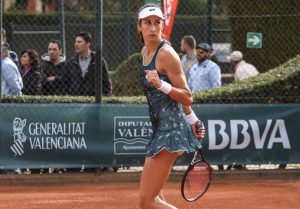
Georgina Garcia Perez holds the record for the fastest serve by a female.
Why is it nearly impossible to hit a 160 mph tennis serve?
A considered calculation of stature, technique, coaching, mechanics and good old practice is said to make the perfect concoction for a fast serve.
A direct correlation has been proven between the height of a player and power during a serve. Therefore, it is no coincidence that the top servers of the game are all giants by nature.
The trajectory of a serve remains ever important. Players who are 6ft 7 or above have the ability to hit the ball with a downward trajectory, whereas those who are under that height are unable to do so.
Modern technology has also greatly aided in the incremental increase of server power over time. The changeover from wooden rackets to today’s modern racket is a huge factor in determining serve power. Advancements in string technology and racket materials also play a huge part in determining a fast serve.
Other mitigating factors include court conditions. Faster serves are much more likely to happen on a hard court and during hotter temperatures, where there is less resistance to air density, translating to faster speeds.
When you compare the fastest tennis serve with other sports, you can see how fast it is.
Fastest Football shot – 114 mph by David Hirst in 1996
Fastest Baseball pitch – 105.1 mph by Aroldis Chapman in 2010
Fastest Cricket Bowling speed – 100.2 mph by Shoaib Akhtar in 2003
What is the average tennis serve speed?
The average tennis serve speed differs between both men and women, as well as between pros and amateurs. Data shows us that for professional male tennis players, the average tennis serve speed is approximately 114 mph (on their first serve) and 93 mph (on their second serve).
For women, the average tennis serve speed clocks in at 98 mph (on their first serve) and 82 mph (on their second serve).
This data was recorded between 2002-2013, so bear in mind the average speeds have likely increased by a few miles per hour in the modern era, as racquet technology and athletes continue to evolve and adapt within the sport.
Check out Wired’s video, which covers the topic more in-depth.
Fancy writing for us: Apply to become a Sports Writer at the Sporting Ferret
If you liked this article, then why not check out:

College Sports
No. 24 Pilots Welcome No. 17 Roos to Merlo Field for Ranked Matchup

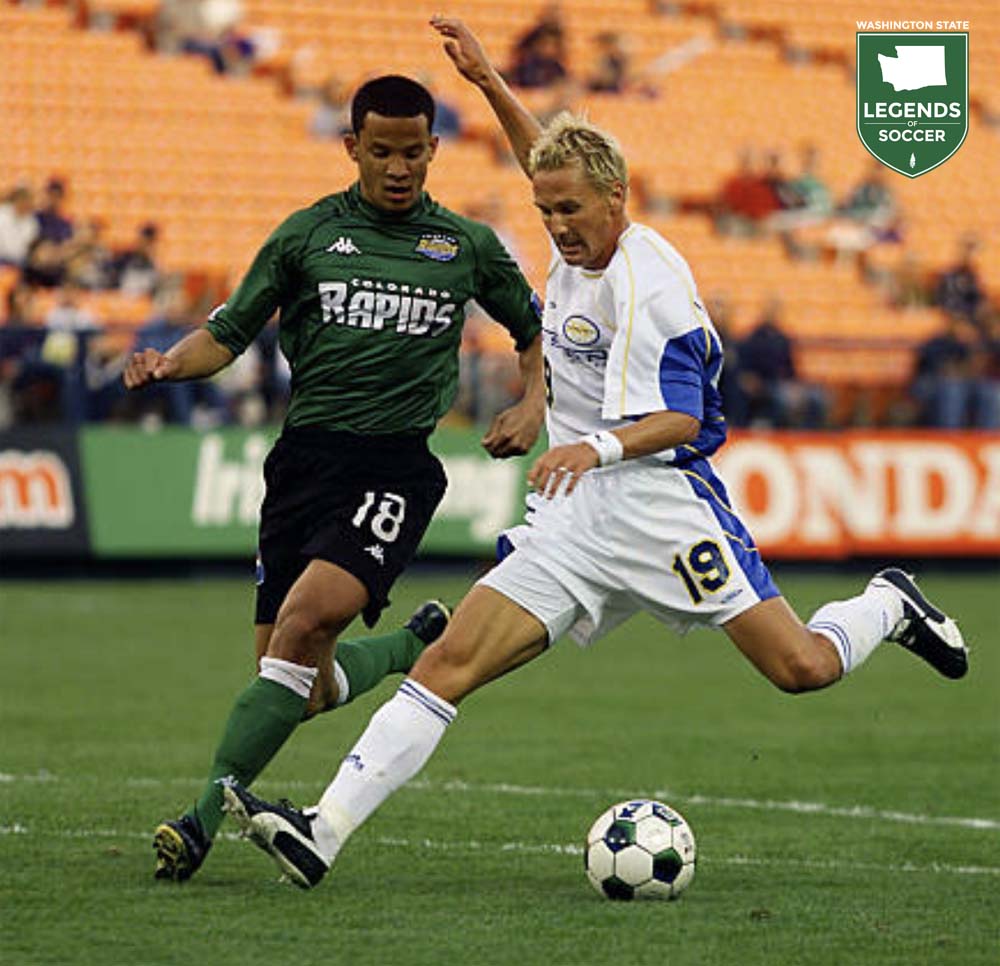
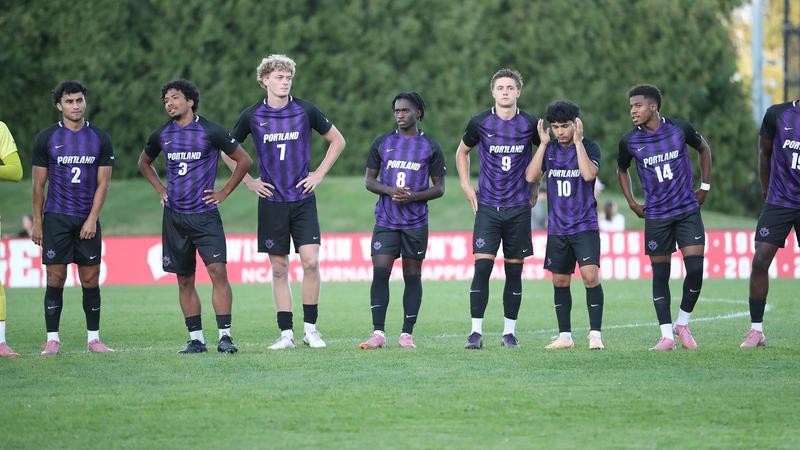
PORTLAND, Ore. – Portland Pilots Men’s Soccer, ranked 24th in the nation, is ready for their first ranked matchup of the season against the Kansas City Roos. The two teams are set to play on Friday, Sept. 5 at 7 p.m. here at Merlo Field.
Tickets for Friday’s game are available at PortlandPilots.com/Tickets. A live stream is also available on ESPN+. Check PortlandPilots.com for links to the live stream and live stats.
MATCH INFORMATION
Opponent: #17/19/RV Kansas City Roos (2-0-2, 0-0-0 Summit)
Day: Friday
Date: Sept. 5, 2025
Time: 7 PM
Place: Portland, Ore.
Pitch: Merlo Field
Video: ESPN+
Stats: PortlandPilots.com
POR vs. UMKC
Overall Series: 0-0-0
H: 0-0-0 • A: 0-0-0 • N: 0-0-0
Last: N/A
PEEK INTO THE PORT
- The Pilots are a perfect 4-0 on the year, outscoring opponents 17-0 in these first four games. They are now ranked 24th nationally.
- They most recently earned a road win over the Wisconsin Badgers 1-0, their eighth win over a Big Ten team and 18th against a Power Four team since Nick Carlin-Voigt took over as head coach in 2016. They also beat the Siena Saints last week 4-0.
- David Ajagbe scored the game-winning goal for the Pilots against the Badgers. Highfield scored two goals against the Saints and Waggoner added another.
- The Pilots lead the nation in 10 different categories, including goals (17), assists (21), points (55), goals-against average (.000), shutout percentage (1.000), save percentage (1.000), points per game (13.75), goal differential (17) and assists per game (5.25)
- Several players are near the top of the nation statistically.
- Diego Rosas is tied with 10 players for first in the nation in assists at four. He posted two assists against Siena on Friday.
- David Ajagbe and Nicholas Dunbar also sit at second in the conference and 13th nationally in assists at three. Ajagbe’s seven points rank second in the WCC and 18th nationally.
- Joe Highfield is one of the top scorers in the nation, sitting at third in points (11), fifth in goals (four) and 11th in assists (three).
- Miguel-Angel Hernandez has yet to allow a goal in his three starts for Portland. He’s one of 14 players to not allow a goal.
- Portland is one of five teams to have started the season 4-0-0 and are the only team in the nation to have started 4-0-0 with four straight shutouts.
- Portland’s 4-0 start is the first time since 1988. It’s also the first time they’ve posted four straight shutouts to start a season since that year.
- The Pilots hold a 14-game unbeaten streak that stretches back to last season.
- This year, they were picked to finish third in the 2025 West Coast Conference Preseason Poll, with forward Joe Highfield and midfielder Efetobo Aror each making the preseason team.
- Highfield was the first Pilot to make the All-WCC First Team and the All-WCC Freshman Team in the same season since Benji Michel in 2016, scoring seven goals and adding three assists. His four goals and three assists against WCC opponents were the second most in the conference.
- Aror was drafted in the first round of the 2025 MLS SuperDraft this past year by the Colorado Rapids but chose to return. The WCC Freshman of the Year in 2023, he played in 10 matches with six starts, recording a goal and assist.
- Aror, along with Pilot newcomer David Ajagbe, was also named to the TopDrawerSoccer Top 100 players in the preseason, slotting in at 52nd. Ajagbe ranks 99th on the list.
- Ajagbe scored seven goals and added two assists with the Ohio State Buckeyes last season, who earned the top overall seed in the NCAA Tournament last year. Ajagbe made the All-Big Ten Freshman team and the TopDrawerSoccer Freshman Best XI Second Team.
- Last season, the Pilots were a dynamic offensive team, ranking second in the WCC in goals per game (1.78), total assists (44), total points (108), points per game (6.00) and assists per game (2.44). Their 2.44 assists per game ranked ninth nationally while their assist total ranked 14th.
- The Pilots also were in the top 50 nationally in points per game, (21st), total points (27th), goals per game (44th) and total goals (32, 46th).
- The Pilots return 16 players from last year’s roster while welcoming 16 newcomers. The incoming class ranks fifth nationally on TopDrawerSoccer.
- Of the 16 returners, Portland returns three players who earned All-WCC honors: Highfield, Miguel-Angel Hernandez (Second Team) and Diego Rosas (Honorable Mention).
- Hernandez played in seven matches last year, posting shutouts in three of those matches.
- Rosas led the Pilots in assists in his second season with the Pilots, posting eight assists. He was the third Pilot since 2017 to post at least three assists in a game, doing so against the LMU Lions.
- Nick Carlin-Voigt enters his 10th year as head coach of the Pilots. He has posted a 92-46-21 record during his tenure, having led Portland to the NCAA Tournament five times during that span.
- Carlin-Voigt was at the helm when the Pilots advanced to the Elite Eight in 2022, their first appearance that deep in the tournament since 1995.
ABOUT THE ROOS
- The Kansas City Roos are 2-0-2 on the year, most recently tying the Saint Mary’s Gaels 1-1 and beating the Northern Illinois Huskies 2-1.
- They are currently receiving votes in the latest Top 25 poll from United Soccer Coaches. They are 17th in the College Soccer News Poll and 19th in TopDrawerSoccer’s poll.
- The Roos were 14-5-3 overall and 5-2-1 in Summit league play. They won the Summit League Championship over the Denver Pioneers and then advanced to the Elite Eight of the NCAA Tournament.
- The Roos were picked second in the Summit League Preseason Poll, with Bryson Gosch and Jeremy Francou making the preseason team.
- Gosch tallied 1,776 minutes last year, earning honorable mention as well as All-Tournament honors. He scored the equalizing goal in the Summit League Championship against Denver.
- Francou scored four goals last year for Kansas City, including a goal in their first-round tournament game against the Saint Louis Bilikens.
- Ryan Pore is in his sixth year at the helm of the Roos. He is 35-33-22 in his six seasons with Kansas City.
Get Your Tickets Now!
Secure your spot now for any upcoming Portland Pilots ticketed home event by visiting PortlandPilots.com/Tickets or by downloading the Portland Pilots App. For group and fan experience package information, email pilotsboxoffice@up.edu.
Donate Today
Fans interested in making a contribution to University of Portland Athletics can do so by clicking here. Your gift helps our over 300 student-athletes compete at the highest level – on and off the field – in the rapidly changing world of intercollegiate athletics. All gifts to Pilot Athletics are 100% tax deductible.
Follow Along With the Action
Get the latest news and information about your favorite University of Portland athletic programs by visiting PortlandPilots.com. You can also follow along for the most dynamic coverage and team-centric content by following us on Twitter, liking us on Facebook, and following us on Instagram.
-

 Motorsports3 weeks ago
Motorsports3 weeks agoRoss Brawn to receive Autosport Gold Medal Award at 2026 Autosport Awards, Honouring a Lifetime Shaping Modern F1
-
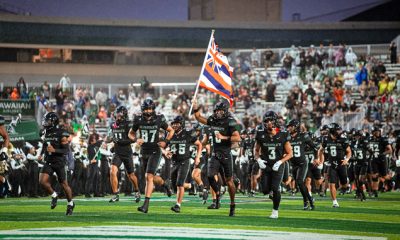
 NIL3 weeks ago
NIL3 weeks agoDowntown Athletic Club of Hawaiʻi gives $300K to Boost the ’Bows NIL fund
-

 Rec Sports2 weeks ago
Rec Sports2 weeks agoPrinceton Area Community Foundation awards more than $1.3 million to 40 local nonprofits ⋆ Princeton, NJ local news %
-

 NIL3 weeks ago
NIL3 weeks agoKentucky AD explains NIL, JMI partnership and cap rules
-
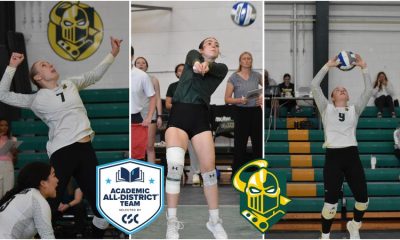
 Sports3 weeks ago
Sports3 weeks agoThree Clarkson Volleyball Players Named to CSC Academic All-District List
-
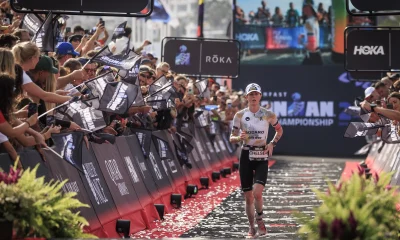
 Sports3 weeks ago
Sports3 weeks agoYoung People Are Driving a Surge in Triathlon Sign-Ups
-

 Sports3 weeks ago
Sports3 weeks agoBeach Volleyball Unveils 2026 Spring Schedule – University of South Carolina Athletics
-
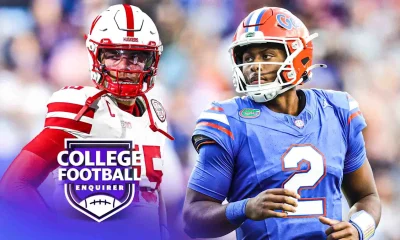
 NIL3 weeks ago
NIL3 weeks agoWhy the NIL era will continue to force more QB transfers
-

 Sports2 weeks ago
Sports2 weeks agoIs women’s volleyball the SEC’s next big sport? How Kentucky, Texas A&M broke through
-
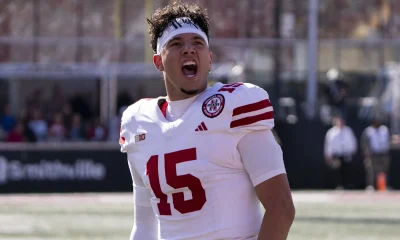
 NIL3 weeks ago
NIL3 weeks agoNew college football program emerges as landing spot for Dylan Raiola
































